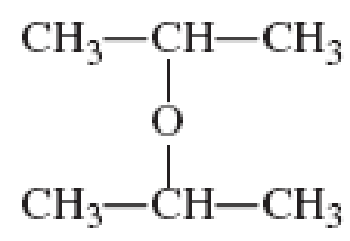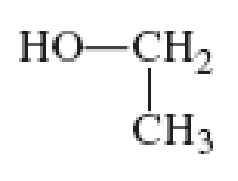
General, Organic, and Biological Chemistry
7th Edition
ISBN: 9781285853918
Author: H. Stephen Stoker
Publisher: Cengage Learning
expand_more
expand_more
format_list_bulleted
Textbook Question
Chapter 14, Problem 14.92EP
Classify each of the following compounds as an ether, an alcohol, or as neither an ether or alcohol.




Expert Solution & Answer
Trending nowThis is a popular solution!

Students have asked these similar questions
None
None
In the solid state, oxalic acid occurs as
a dihydrate with the formula H2C2O4
C+2H2O. Use this formula to
calculate the formula weight of oxalic
acid. Use the calculated formula
weight and the number of moles
(0.00504mol)
of oxalic acid in each titrated
unknown sample recorded in Table
6.4 to calculate the number of grams
of pure oxalic acid dihydrate
contained in each titrated unknown
sample.
Chapter 14 Solutions
General, Organic, and Biological Chemistry
Ch. 14.1 - Prob. 1QQCh. 14.1 - Prob. 2QQCh. 14.2 - Prob. 1QQCh. 14.2 - Prob. 2QQCh. 14.2 - Prob. 3QQCh. 14.3 - Prob. 1QQCh. 14.3 - Prob. 2QQCh. 14.3 - Prob. 3QQCh. 14.3 - Prob. 4QQCh. 14.4 - Prob. 1QQ
Ch. 14.4 - Prob. 2QQCh. 14.4 - Prob. 3QQCh. 14.5 - Prob. 1QQCh. 14.5 - Prob. 2QQCh. 14.5 - Prob. 3QQCh. 14.5 - Prob. 4QQCh. 14.6 - Prob. 1QQCh. 14.6 - Prob. 2QQCh. 14.6 - Prob. 3QQCh. 14.7 - Prob. 1QQCh. 14.7 - Prob. 2QQCh. 14.8 - Prob. 1QQCh. 14.8 - Prob. 2QQCh. 14.9 - Prob. 1QQCh. 14.9 - Prob. 2QQCh. 14.9 - Prob. 3QQCh. 14.9 - Prob. 4QQCh. 14.9 - Prob. 5QQCh. 14.9 - Prob. 6QQCh. 14.10 - Prob. 1QQCh. 14.10 - Prob. 2QQCh. 14.11 - Prob. 1QQCh. 14.11 - Prob. 2QQCh. 14.11 - Prob. 3QQCh. 14.12 - Prob. 1QQCh. 14.12 - Prob. 2QQCh. 14.13 - Prob. 1QQCh. 14.13 - Prob. 2QQCh. 14.13 - Prob. 3QQCh. 14.14 - Prob. 1QQCh. 14.14 - Prob. 2QQCh. 14.14 - Prob. 3QQCh. 14.15 - Prob. 1QQCh. 14.15 - Prob. 2QQCh. 14.15 - Prob. 3QQCh. 14.15 - Prob. 4QQCh. 14.16 - Prob. 1QQCh. 14.16 - Prob. 2QQCh. 14.17 - Prob. 1QQCh. 14.17 - Prob. 2QQCh. 14.17 - Prob. 3QQCh. 14.18 - Prob. 1QQCh. 14.18 - Prob. 2QQCh. 14.18 - Prob. 3QQCh. 14.19 - Prob. 1QQCh. 14.19 - Prob. 2QQCh. 14.20 - Prob. 1QQCh. 14.20 - Prob. 2QQCh. 14.20 - Prob. 3QQCh. 14.20 - Prob. 4QQCh. 14.20 - Prob. 5QQCh. 14.21 - Prob. 1QQCh. 14.21 - Prob. 2QQCh. 14.21 - Prob. 3QQCh. 14.21 - Prob. 4QQCh. 14.21 - Prob. 5QQCh. 14 - Prob. 14.1EPCh. 14 - Prob. 14.2EPCh. 14 - Prob. 14.3EPCh. 14 - Prob. 14.4EPCh. 14 - Prob. 14.5EPCh. 14 - Prob. 14.6EPCh. 14 - Prob. 14.7EPCh. 14 - Prob. 14.8EPCh. 14 - Prob. 14.9EPCh. 14 - Prob. 14.10EPCh. 14 - Write a condensed structural formula for each of...Ch. 14 - Write a condensed structural formula for each of...Ch. 14 - Prob. 14.13EPCh. 14 - Prob. 14.14EPCh. 14 - Prob. 14.15EPCh. 14 - Prob. 14.16EPCh. 14 - Prob. 14.17EPCh. 14 - Prob. 14.18EPCh. 14 - Each of the following alcohols is named...Ch. 14 - Prob. 14.20EPCh. 14 - Prob. 14.21EPCh. 14 - Prob. 14.22EPCh. 14 - Prob. 14.23EPCh. 14 - Prob. 14.24EPCh. 14 - Prob. 14.25EPCh. 14 - Prob. 14.26EPCh. 14 - Prob. 14.27EPCh. 14 - Prob. 14.28EPCh. 14 - Prob. 14.29EPCh. 14 - Prob. 14.30EPCh. 14 - Prob. 14.31EPCh. 14 - Prob. 14.32EPCh. 14 - Prob. 14.33EPCh. 14 - Prob. 14.34EPCh. 14 - Explain why the boiling points of alcohols are...Ch. 14 - Explain why the water solubilities of alcohols are...Ch. 14 - Prob. 14.37EPCh. 14 - Prob. 14.38EPCh. 14 - Prob. 14.39EPCh. 14 - Which member of each of the following pairs of...Ch. 14 - Determine the maximum number of hydrogen bonds...Ch. 14 - Determine the maximum number of hydrogen bonds...Ch. 14 - Prob. 14.43EPCh. 14 - Prob. 14.44EPCh. 14 - Prob. 14.45EPCh. 14 - Prob. 14.46EPCh. 14 - Classify each of the following alcohols as a...Ch. 14 - Classify each of the following alcohols as a...Ch. 14 - Classify each of the following alcohols as a...Ch. 14 - Classify each of the following alcohols as a...Ch. 14 - Prob. 14.51EPCh. 14 - Prob. 14.52EPCh. 14 - Prob. 14.53EPCh. 14 - Prob. 14.54EPCh. 14 - Prob. 14.55EPCh. 14 - Prob. 14.56EPCh. 14 - Prob. 14.57EPCh. 14 - Prob. 14.58EPCh. 14 - Prob. 14.59EPCh. 14 - Prob. 14.60EPCh. 14 - The alcohol 2,2-dimethyl-1-butanol cannot be...Ch. 14 - Prob. 14.62EPCh. 14 - Prob. 14.63EPCh. 14 - Prob. 14.64EPCh. 14 - Draw the structure of the aldehyde or ketone...Ch. 14 - Draw the structure of the aldehyde or ketone...Ch. 14 - Prob. 14.67EPCh. 14 - Prob. 14.68EPCh. 14 - Prob. 14.69EPCh. 14 - Prob. 14.70EPCh. 14 - Three isomeric pentanols with unbranched carbon...Ch. 14 - Prob. 14.72EPCh. 14 - Prob. 14.73EPCh. 14 - Prob. 14.74EPCh. 14 - Prob. 14.75EPCh. 14 - Prob. 14.76EPCh. 14 - Prob. 14.77EPCh. 14 - Prob. 14.78EPCh. 14 - Prob. 14.79EPCh. 14 - Prob. 14.80EPCh. 14 - Prob. 14.81EPCh. 14 - Prob. 14.82EPCh. 14 - Prob. 14.83EPCh. 14 - Prob. 14.84EPCh. 14 - Prob. 14.85EPCh. 14 - Prob. 14.86EPCh. 14 - Prob. 14.87EPCh. 14 - Prob. 14.88EPCh. 14 - Prob. 14.89EPCh. 14 - Prob. 14.90EPCh. 14 - Prob. 14.91EPCh. 14 - Classify each of the following compounds as an...Ch. 14 - Draw or write the following for the simplest ether...Ch. 14 - Draw or write the following for the simplest ether...Ch. 14 - Prob. 14.95EPCh. 14 - Prob. 14.96EPCh. 14 - Prob. 14.97EPCh. 14 - Prob. 14.98EPCh. 14 - Prob. 14.99EPCh. 14 - Prob. 14.100EPCh. 14 - Prob. 14.101EPCh. 14 - Prob. 14.102EPCh. 14 - Prob. 14.103EPCh. 14 - Prob. 14.104EPCh. 14 - Prob. 14.105EPCh. 14 - Prob. 14.106EPCh. 14 - Prob. 14.107EPCh. 14 - Prob. 14.108EPCh. 14 - Prob. 14.109EPCh. 14 - Prob. 14.110EPCh. 14 - Prob. 14.111EPCh. 14 - Prob. 14.112EPCh. 14 - Prob. 14.113EPCh. 14 - Give common names for all ethers that are...Ch. 14 - How many isomeric ethers exist when the R groups...Ch. 14 - Prob. 14.116EPCh. 14 - Prob. 14.117EPCh. 14 - Draw condensed structural formulas for the...Ch. 14 - Prob. 14.119EPCh. 14 - Prob. 14.120EPCh. 14 - Prob. 14.121EPCh. 14 - Prob. 14.122EPCh. 14 - Prob. 14.123EPCh. 14 - How do the chemical reactivities of ethers compare...Ch. 14 - Explain why ether molecules cannot hydrogen-bond...Ch. 14 - How many hydrogen bonds can form between a single...Ch. 14 - Classify each of the following molecular...Ch. 14 - Classify each of the following molecular...Ch. 14 - Prob. 14.129EPCh. 14 - Prob. 14.130EPCh. 14 - Prob. 14.131EPCh. 14 - Draw a condensed structural formula for each of...Ch. 14 - Prob. 14.133EPCh. 14 - Prob. 14.134EPCh. 14 - Prob. 14.135EPCh. 14 - Prob. 14.136EPCh. 14 - Prob. 14.137EPCh. 14 - For each of the following pairs of compounds,...Ch. 14 - Assign an IUPAC name to each of the following...Ch. 14 - Prob. 14.140EPCh. 14 - Prob. 14.141EPCh. 14 - Prob. 14.142EPCh. 14 - Prob. 14.143EPCh. 14 - Prob. 14.144EPCh. 14 - Prob. 14.145EPCh. 14 - Prob. 14.146EP
Knowledge Booster
Learn more about
Need a deep-dive on the concept behind this application? Look no further. Learn more about this topic, chemistry and related others by exploring similar questions and additional content below.Similar questions
- 1. Consider a pair of elements with 2p and 4p valence orbitals (e.g., N and Se). Draw their (2p and 4p AO's) radial probability plots, and sketch their angular profiles. Then, consider these orbitals from the two atoms forming a homonuclear л-bond. Which element would have a stronger bond, and why? (4 points)arrow_forwardWrite the reaction and show the mechanism of the reaction. Include the mechanism for formation of the NO2+ 2. Explain, using resonance structures, why the meta isomer is formed. Draw possible resonance structures for ortho, meta and para.arrow_forwardNonearrow_forward
- 3. A molecular form of "dicarbon", C2, can be generated in gas phase. Its bond dissociation energy has been determined at 599 kJ/mol. Use molecular orbital theory to explain why energy of dissociation for C₂+ is 513 kJ/mol, and that for C2² is 818 kJ/mol. (10 points)arrow_forward9.73 g of lead(IV) chloride contains enough Cl- ions to make ____ g of magnesium chloride.arrow_forward6. a) C2's. Phosphorus pentafluoride PF5 belongs to D3h symmetry group. Draw the structure of the molecule, identify principal axis of rotation and perpendicular (4 points) b) assume that the principal axis of rotation is aligned with z axis, assign symmetry labels (such as a1, b2, etc.) to the following atomic orbitals of the P atom. (character table for this group is included in the Supplemental material). 3s 3pz (6 points) 3dz²arrow_forward
- 2. Construct Lewis-dot structures, and draw VESPR models for the ions listed below. a) SiF5 (4 points) b) IOF4 (4 points)arrow_forward5. Complex anion [AuCl2]¯ belongs to Doh symmetry point group. What is the shape of this ion? (4 points)arrow_forward4. Assign the following molecules to proper point groups: Pyridine N 1,3,5-triazine N Narrow_forward
- 7. a) Under normal conditions (room temperature & atmospheric pressure) potassium assumes bcc lattice. Atomic radius for 12-coordinate K atom is listed as 235 pm. What is the radius of potassium atom under normal conditions? (3 points) b) Titanium metal crystallyzes in hcp lattice. Under proper conditions nitrogen can be absorbed into the lattice of titanium resulting in an alloy of stoichiometry TiNo.2. Is this compound likely to be a substitutional or an interstitial alloy? (Radius of Ti (12-coordinate) is 147 pm; radius of N atom is 75 pm. (3 points)arrow_forwardcan someone answer the questions and draw out the complete mechanismarrow_forwardPlease help, draw and me the proper mechanisms.arrow_forward
arrow_back_ios
SEE MORE QUESTIONS
arrow_forward_ios
Recommended textbooks for you
 Organic And Biological ChemistryChemistryISBN:9781305081079Author:STOKER, H. Stephen (howard Stephen)Publisher:Cengage Learning,
Organic And Biological ChemistryChemistryISBN:9781305081079Author:STOKER, H. Stephen (howard Stephen)Publisher:Cengage Learning, General, Organic, and Biological ChemistryChemistryISBN:9781285853918Author:H. Stephen StokerPublisher:Cengage Learning
General, Organic, and Biological ChemistryChemistryISBN:9781285853918Author:H. Stephen StokerPublisher:Cengage Learning Introductory Chemistry: An Active Learning Approa...ChemistryISBN:9781305079250Author:Mark S. Cracolice, Ed PetersPublisher:Cengage Learning
Introductory Chemistry: An Active Learning Approa...ChemistryISBN:9781305079250Author:Mark S. Cracolice, Ed PetersPublisher:Cengage Learning Chemistry for Today: General, Organic, and Bioche...ChemistryISBN:9781305960060Author:Spencer L. Seager, Michael R. Slabaugh, Maren S. HansenPublisher:Cengage Learning
Chemistry for Today: General, Organic, and Bioche...ChemistryISBN:9781305960060Author:Spencer L. Seager, Michael R. Slabaugh, Maren S. HansenPublisher:Cengage Learning World of Chemistry, 3rd editionChemistryISBN:9781133109655Author:Steven S. Zumdahl, Susan L. Zumdahl, Donald J. DeCostePublisher:Brooks / Cole / Cengage Learning
World of Chemistry, 3rd editionChemistryISBN:9781133109655Author:Steven S. Zumdahl, Susan L. Zumdahl, Donald J. DeCostePublisher:Brooks / Cole / Cengage Learning Chemistry: Principles and PracticeChemistryISBN:9780534420123Author:Daniel L. Reger, Scott R. Goode, David W. Ball, Edward MercerPublisher:Cengage Learning
Chemistry: Principles and PracticeChemistryISBN:9780534420123Author:Daniel L. Reger, Scott R. Goode, David W. Ball, Edward MercerPublisher:Cengage Learning

Organic And Biological Chemistry
Chemistry
ISBN:9781305081079
Author:STOKER, H. Stephen (howard Stephen)
Publisher:Cengage Learning,

General, Organic, and Biological Chemistry
Chemistry
ISBN:9781285853918
Author:H. Stephen Stoker
Publisher:Cengage Learning

Introductory Chemistry: An Active Learning Approa...
Chemistry
ISBN:9781305079250
Author:Mark S. Cracolice, Ed Peters
Publisher:Cengage Learning

Chemistry for Today: General, Organic, and Bioche...
Chemistry
ISBN:9781305960060
Author:Spencer L. Seager, Michael R. Slabaugh, Maren S. Hansen
Publisher:Cengage Learning

World of Chemistry, 3rd edition
Chemistry
ISBN:9781133109655
Author:Steven S. Zumdahl, Susan L. Zumdahl, Donald J. DeCoste
Publisher:Brooks / Cole / Cengage Learning

Chemistry: Principles and Practice
Chemistry
ISBN:9780534420123
Author:Daniel L. Reger, Scott R. Goode, David W. Ball, Edward Mercer
Publisher:Cengage Learning
07 Physical Properties of Organic Compounds; Author: Mindset;https://www.youtube.com/watch?v=UjlSgwq4w6U;License: Standard YouTube License, CC-BY